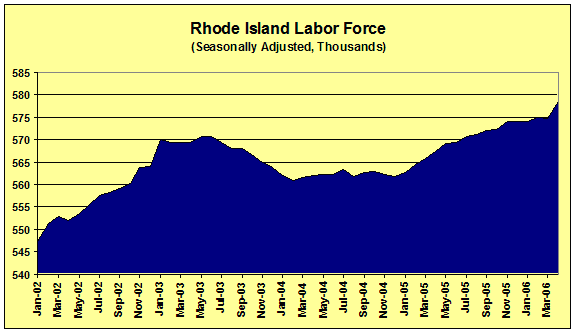 |
|
|
|
LABOR
FORCE IS ACTING Over the past year, Rhode Islandís labor force growth has been surprisingly strong. When measured on a year-over-year basis, recent growth has reached as high as 2.2 percent, something we havenít seen in several years. Might there be a structural change currently taking place? Is there greater underlying strength in Rhode Islandís economy than we might have previously thought? What underlies the recent strength in our labor force growth is the aftermath of a strange occurrence: starting in June of 2003, Rhode Islandís labor force began a period where it actually declined significantly for well over a year. Thatís not supposed to happen during an economic recovery. Typically, an improving economy draws persons back into the labor force based on more favorable job prospects, resulting in labor force growth.
But thatís not what happened in Rhode Island. In June of 2003, our labor force reached its early recovery high of 570,600 (seasonally adjusted with rounding). Thereafter, our labor force fell then remained at these diminished levels until it began a period of sustained growth in December of 2004. In fact, it wasnít until July of last year that our labor force matched its early recovery high. (see the chart) Believe it or not, things get even stranger. For all of 2004, Rhode Islandís labor force declined by 6,250. Typically, when the labor force here declines, we often observe a similar drop in the number of unemployed, as unemployed workers ďdrop out,Ē resulting in a declining unemployment rate. For 2004, the number of unemployed declined by (only) 1,200. Resident employment, the number of employed Rhode Islanders, fell by 5,050, accounting for about 80 percent of the labor force decline. Thatís a new one for me! Part of what is at work here is most likely the exit of employed Rhode Islanders who ďcashed inĒ their home equity here and moved to other states to begin employment. Even if they did not become employed immediately, their home equity very likely subsidized a fair amount of job search, as it was well beyond what was necessary to purchase adequate housing in the new location. This is the downside of our recent housing boom: lots of home equity plus lagging job growth is a very bad combination! More skilled persons have likely left Rhode Island then have moved here from other parts of the country, since housing here is so expensive. This troubling asymmetry is yet another manifestation of Rhode Islandís non-competitive tax and cost structure. Finally, where this all ends up is that during 2006, we have been comparing recent and rising labor force levels with depressed levels from a year ago, resulting in what appear to be significantly high growth rates. Anyone looking at these data should be careful to avoid interpreting recent labor force growth as indicative of underlying strength. Instead, our strong growth rates result from having weak ďcompsĒ last year. Starting in about a month, these weak comps will disappear. It will be interesting to see how Rhode Islandís labor force growth fares, especially since the US economy will grow more slowly during the second half of this year.
by Leonard Lardaro |
|
|
|
